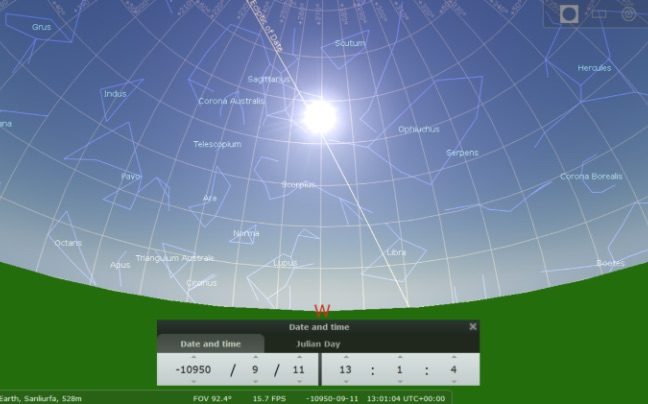
Eksperter ved Edinburg University har analyseret mystiske symboler indhugget i stensøjler ved Gobekli Tepe i det sydlige Tyrkiet for at se, om de kunne knyttes til stjernetegnene.
Tegnene indikerer, at en sværm af kometfragmenter ramte jorden på præcis samme tid, som miniistiden indtrådte og dermed ændrede hele den menneskelige historie.
Videnskabsfolk har i årtier spekuleret på, om en komet kunne være bag det pludselige fald i temperaturen under perioden kendt som Yngre Dryas. Men for nylig tegnede alt til at teorien var afvist gennem en ny datering af meteorkratere i Nordamerika, hvor man mener, at kometen havde ramt.
Imidlertid har ingeniører studeret indhugninger foretaget på en stensøjle - kendt som gribbestenen, (Eng: Vulture Stone) - i Gobekli Tepe. De opdagede, at væsnerne på stenen faktisk var astronomiske symboler, som repræsenterede stjernetegn og kometen.
Kommentar: Delvist oversat af Sott.net fra Stone carvings at Gobekli Tepe in Turkey confirm how comet struck Earth in 10,950BC
The idea had been originally put forward by author Graham Hancock in his book Magicians of the Gods.
Using a computer programme to show where the constellations would have appeared above Turkey thousands of years ago, they were able to pinpoint the comet strike to 10,950BC, the exact time the Younger Dryas begins according to ice core data from Greenland.
The Younger Dryas is viewed as a crucial period for humanity, as it roughly coincides with the emergence of agriculture and the first Neolithic civilisations.
Before the strike, vast areas of wild wheat and barley had allowed nomadic hunters in the Middle East to establish permanent base camps. But the difficult climate conditions following the impact forced communities to come together and work out new ways of maintaining the crops, through watering and selective breeding. Thus farming began, allowing the rise of the first towns.
Edinburgh researchers said the carvings appear to have remained important to the people of Gobekli Tepe for millennia, suggesting that the event and cold climate that followed likely had a very serious impact.
Dr Martin Sweatman, of the University of Edinburgh's School of Engineering, who led the research, said: "I think this research, along with the recent finding of a widespread platinum anomaly across the North American continent virtually seal the case in favour of (a Younger Dryas comet impact).
"Our work serves to reinforce that physical evidence. What is happening here is the process of paradigm change.
"It appears Göbekli Tepe was, among other things, an observatory for monitoring the night sky.
"One of its pillars seems to have served as a memorial to this devastating event - probably the worst day in history since the end of the ice age."
Gobekli Tepe, is thought to be the world's oldest temple site, which dates from around 9,000BC, predating Stonehenge by around 6,000 years.
Researchers believe the images were intended as a record of the cataclysmic event, and that a further carving showing a headless man may indicate human disaster and extensive loss of life.
Symbolism on the pillars also indicates that the long-term changes in Earth's rotational axis was recorded at this time using an early form of writing, and that Gobekli Tepe was an observatory for meteors and comets.
The finding also supports a theory that Earth is likely to experience periods when comet strikes are more likely, owing to the planet's orbit intersecting orbiting rings of comet fragments in space.
But despite the ancient age of the pillars, Dr Sweatman does not believe it is the earliest example of astronomy in the archaeological record.
"Many paleolithic cave paintings and artefacts with similar animal symbols and other repeated symbols suggest astronomy could be very ancient indeed," he said.
"If you consider that, according to astronomers, this giant comet probably arrived in the inner solar system some 20 to 30 thousand years ago, and it would have been a very visible and dominant feature of the night sky, it is hard to see how ancient people could have ignored this given the likely consequences."
The research is published in Mediterranean Archaeology and Archaeometry.





Kommentar: See also: Forget About Global Warming: We're One Step From Extinction!